Yasmin Hossain makes natural dye from garden plants. She uses it to dye beautiful silk and wool fabrics.
And I believe that grow-your-own dyes from garden plants is a trend that will grow enormously in popularity in the next few years.
It’s creative and almost anyone can do it, although there’s a certain amount of experimentation involved. If, for example, you’re a knitter or crafter, how much more exciting is it to dye your own wool and felt? Especially as you’re using ingredients that would otherwise be thrown away, such as vegetable skins and dead flower heads.

The soft pink blanket is dyed with natural dye made from avocado skins and stones. The yellow one is dyed from daffodil heads from Doddington Place.
Yasmin experiments with flower dyes in her own home. She is also one of a partnership in Juniper & Bliss who make clothes and bedding from natural organic materials, dyed with plant dyes. Juniper and Bliss aim to be completely sustainable and ‘zero waste’. ‘We want to leave the lightest environmental footprint,’ says Yasmin.
Fabrics are made and dyed by small scale producers and artisanal co-operatives around the world, such as Scottish micro-mills or co-operatives in India. Clothes and bedding are then sewn in atelier protege in Belgium. (This roughly translates as ‘protected workshop’, along Fair Trade principles.)

Avocado skins and pips, given to Yasmin by a local cafe, waiting to be distilled into dye in Yasmin’s kitchen.
Flowers and vegetable skins for dyes at home
At home in Kent, Yasmin brews up avocado pips and skins from a local cafe and asks beautiful local garden Doddington Place if she can have their daffodil deadheads in late spring. She is even drying a bunch of flowers sent to her as a gift.
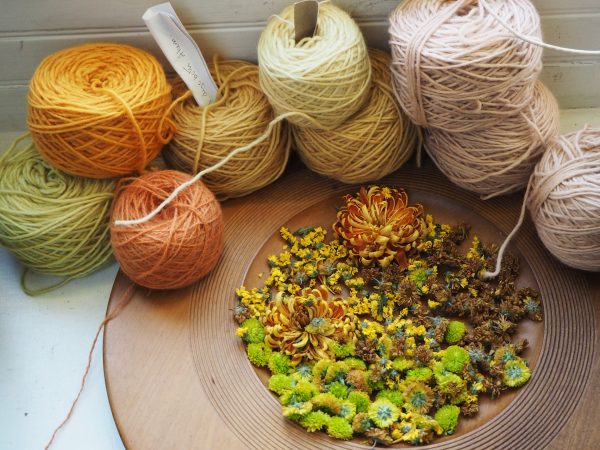
These are dried flower heads from a bunch of flowers given to Yasmin as a gift. They will soon be brewed up to create beautiful, natural colours for dye.
I recently did a video on dyeing tablecloths with Dylon, but it can’t be used for wool or silk. So when I heard about Yasmin’s natural dyeing, I was keen to hear more.
I wrote about how to create stunning dyes from your garden plants after interviewing a friend in Australia who is ‘mapping her garden with dye plants.’ And in the RHS Chelsea Flower Show 2016 a Dyer’s Garden was featured for the first time (reviewed here by the Reckless Gardener.)
And now that cut flowers are joining the grow-your-own movement, along with a desire to minimise waste and chemicals, I think the trend towards using natural dyes in your own home can only grow and grow.
First choose your flower or plant
I joined Yasmin for a dyeing session using avocado skins and pips. The principles of natural dyeing are approximately the same for many flowers and plants.
However, natural dyers are always trying things out and tweaking their recipes, so keep a note of how your natural dye turns out. More avocado skins and pips? A longer boiling time? Do you need to add a fixative (known as a mordant)? Each recipe is different, so let’s go from start to finish with Yasmin’s avocados.
If your household eats alot of avocados, you can save the skins and stones, but Yasmin gets hers from a local cafe. The discarded material sits in a bowl in her living room or kitchen until she’s ready to brew up.
I’ve done a video showing the process, which you can see below:
Brew it up
Yasmin added a few handfuls of avocado skins and stones to a large stainless steel pan. She added water, to a depth of two to three times. Then she brings it to the boil and simmers it for around an hour until she estimates the dye is strong enough.
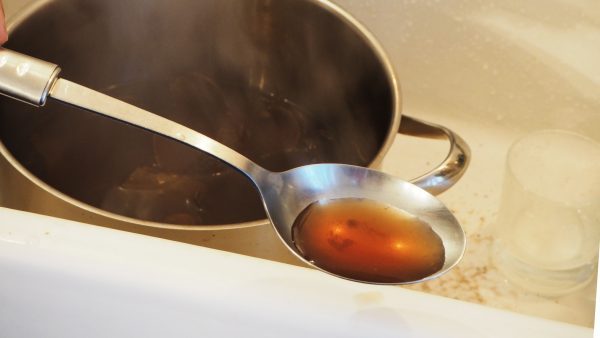
Check the strength of the dye with a spoon. Just over an hour later, it looks about right to Yasmin.
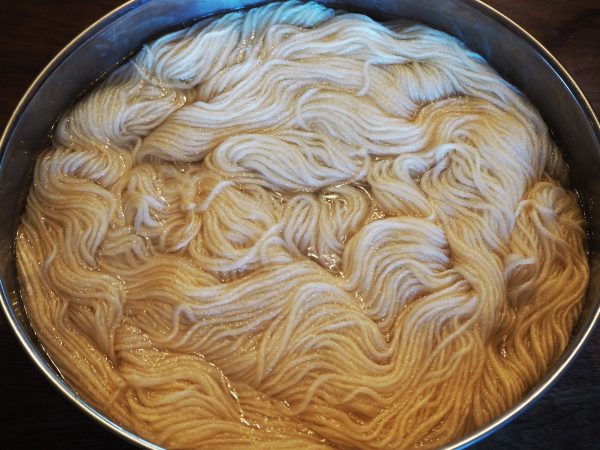
Meanwhile, in another stainless steel bowl, the natural wool is soaking in water.
The wool or cotton needs to be wet if it is to take the dye evenly, so soak it in another bowl while you’re making the dye.
The next stage – add the natural dye to the wool or fabric
Squeeze out the cotton or wool so that it is damp, but not soaking.
Then strain the dye liquid. You may be able to brew up another dye from the same material, and the ‘2nd dye bath’ will come out slightly different (usually paler, not surprisingly).
Allow the dye liquid to cool a little before adding the fabric.

Remove larger pieces with a slotted spoon, then drain the liquid with a sieve to get the detritus out.

Return the pan to the heat, but be careful not to allow it to boil for more than a few seconds or it will felt the wool.
Swirl the wool or fabric around in the pan so that the liquid is evenly distributed. Then return the pan to the heat, bringing it very briefly to the boil.
Turn it down to simmer immediately and simmer for around an hour. Don’t let it boil or it will felt the wool.
Not all natural dyes need to be boiled. Yasmin had a large pot of eucalptus leaves infusing in her kitchen, and these won’t be heated up.
When the wool is approximately the shade you want, lift it out of the dyeing water, and hang it up to dry. It will probably be paler when dry, so experiment a bit.
I’d say the process is similar to making marmalade in terms of time and effort. It takes quite a long time, because of all the simmering and steeping, but for most of that time, it’s just brewing away without much interference from you. We were able to enjoy a delightful lunch while the dye was boiling and simmering.
Finally…
When you judge that the dye is ready, drain the dye and gently wash the wool in a very mild detergent. Wool doesn’t like going from one extreme of temperature to another. So allow it to cool a little and also use warm water for washing it. Once any excess dye has been washed out, hang the wool or cotton up to dry.
More colours from natural plant dyes
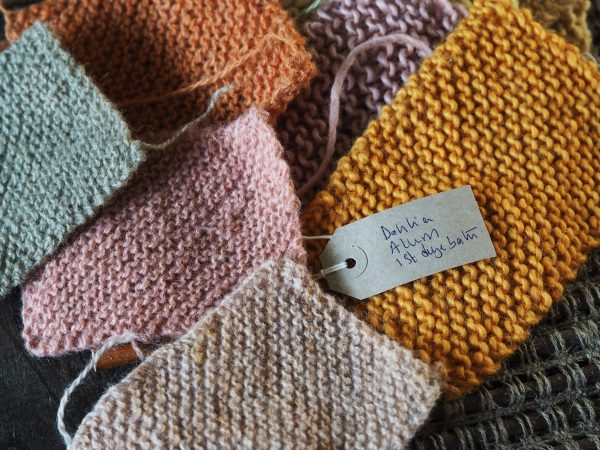
The orange swatch was made from Black Cat dahlia, which I also have here. It’s a very deep red -so plant colours don’t always turn out the way you expect.
Plant dyeing is very low tech, and plant dyers experiment with their recipes and take notes. If you want to read more before starting, India Flint is the guru on natural plant dyeing. Start with her book Eco Colour – Botanical Dyes for Beautiful Textiles.
The Modern Natural Dyer, A Comprehensive Guide to Dyeing Silk, Wool, Linen and Cotton at Home by Kristine Vejar is also highly rated. And gardeners who want to think about what to plant in their garden should enjoy Rita Buchanan’s The Weaver’s Garden.
Note: links to Amazon are affiliate links, which means I may receive a small fee if you buy through them, but it won’t affect the price you pay.
There are also workshops where you can learn about dyeing. These include day and weekend workshops from Flora Arbuthnott. Craft Courses is a website that lists dyeing, spinning and other crafting courses around the UK.
Pin for reference:
The post Natural dye from your garden – beautiful, creative and easy appeared first on The Middle-Sized Garden.
from The Middle-Sized Garden http://www.themiddlesizedgarden.co.uk/natural-dye-from-your-garden-beautiful-creative-and-easy/
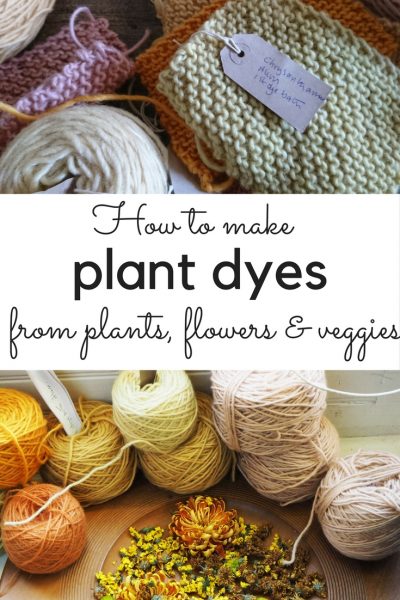
No comments:
Post a Comment